Strawberries are grown commercially for the fresh fruit market, as well as for freezing, preserving, and the production of strawberry jam.
In addition, strawberries are used as a decoration or flavoring in many prepared foods. The plant has a short stem and produces leaves that are toothed and fragrant.
The flowers are white with five petals and produce berries that are red, edible, and seeded. 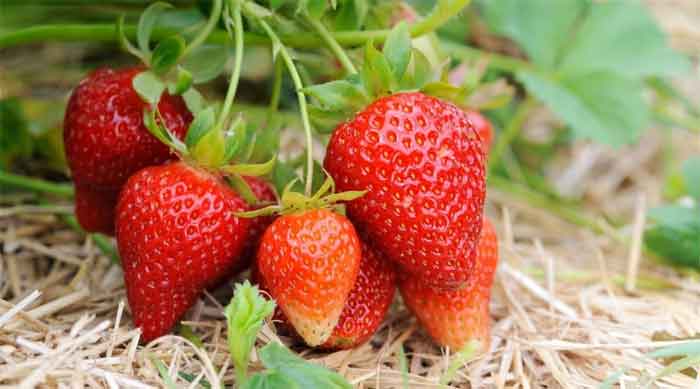 The berry is an enlarged receptacle that contains small achenes that each bear a single seed.
The berry is an enlarged receptacle that contains small achenes that each bear a single seed.
Strawberry Plan Identification
Despite their name, strawberries are not berries or fruit, but rather the stamens of the plant’s flowers. Strawberry plants produce tiny black dots on the “berry” known as fruits. 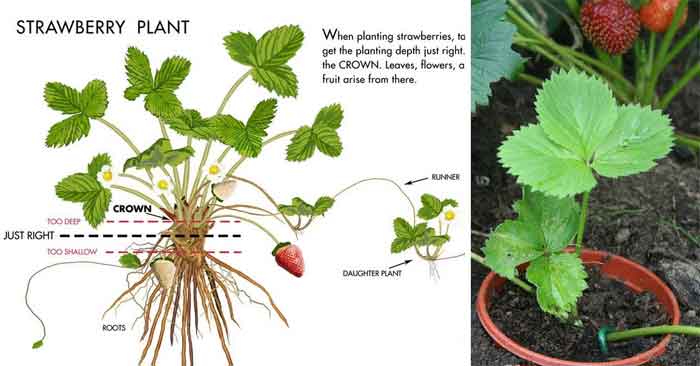
The seeds may develop into new strawberry plants, but most strawberry plants reproduce via runners instead.
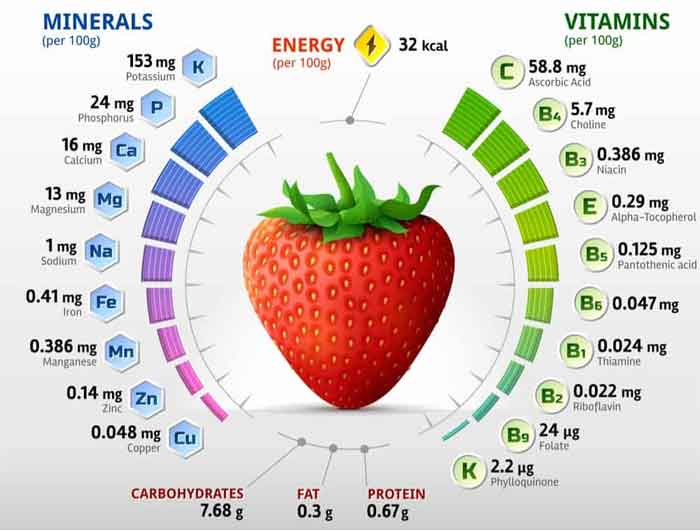
Strawberry plants have been observed creating mat-like colonies that can live up to 50 years under specific circumstances.
Also read about jute plant here for your reference.
Types of Strawberry
The type of cultivar appropriate for a given environment is determined by personal preference and growing conditions. 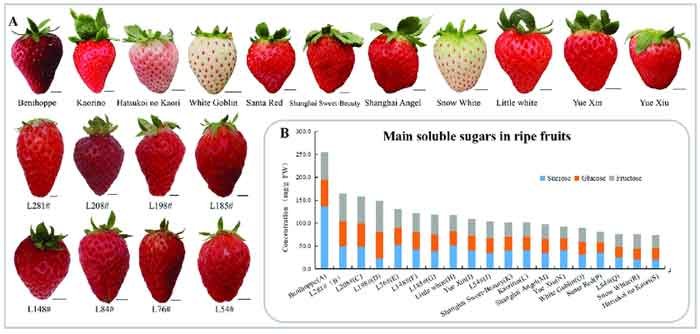 “Diamante,” for example, is susceptible to brain damage, whereas the “Camarosa” is more resilient; while the “Camino Real” is extremely resistant to rain damage.
“Diamante,” for example, is susceptible to brain damage, whereas the “Camarosa” is more resilient; while the “Camino Real” is extremely resistant to rain damage.
When strawberries are picked, the sugar converts to starch. Strawberry plants exist in three forms:
- June-bearing strawberries develop fruit all at once, generally over three weeks. These strawberries are day-length sensitive and create buds, flowers, and fruits the following June, as well as runners throughout the long summer days. Although they are known as “June-bearers” or “June-bearers,” in warmer climes, these strawberries develop earlier than June.
- Everbearing plants produce a large harvest in the spring, a small one in the summer, and another crop in the late fall/early winter. The summer-formed buds bloom and fruit in autumn, while those formed during the fall bloom and fruit the following year.
- Vegetable and flower varieties that are day-neutral bear fruit all year, so long as the weather is between 35° and 85°F (1° to 30°C): These types of vegetable plants produce buds, fruits, and runners constantly if the temperature remains between 35 ° and 85 °F (1 ° to 30 °C).
Want to know about types of tulsi plant? Here you go.
Strawberries from Planting to Harvest
Planting
To keep strawberry quality high throughout the year, start new plants each year. 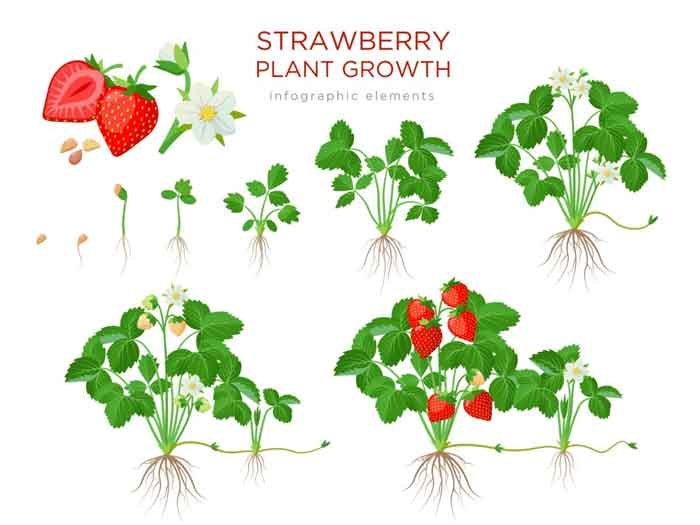 Strawberry runners (daughter plants) develop from strawberry plants and roots and grow into new strawberries.
Strawberry runners (daughter plants) develop from strawberry plants and roots and grow into new strawberries.
Consider reading about shami plant here.
Choosing a Planting Location and Preparing It
- Strawberry plants thrive in direct sunlight for 6-10 hours each day, so choose a location that provides this.
- Strawberries grow best in moist, loamy soil that drains well. Strawberries prefer slightly drained loamy soil.
- Strawberries require a soil pH of between 5.5 and 7, as determined by the USDA Plant Hardiness Zone Map. If you live in an area with naturally alkaline soil, strawberries may be grown in half-barrels or similar large containers containing compost-enriched potting soil.
- The soil must be well-drained. Strawberry plants can thrive in raised beds, which are an ideal choice for them.
Also read about elaichi plant here as well.
Strawberries: How to Plant Them?
- Leave room for spreading by providing an adequate area for sprawl. Strawberries are spreading plants. Seedlings will send out branches, which in turn will produce their roots as they grow.
- Don’t plant too deeply! The roots should be hidden but the crown should protrude from the surface of the earth. You must expose the leaves, flowers, and fruit of your plant to light and fresh air.
- It’s also feasible to produce strawberries from last year’s runners.
You may also like to read:
Growing
- Mulch to keep the soil wet and the plants clean. Mulches of all types, including black plastic, pine straw, and shredded leaves, will keep the soil wet while keeping the plants clean.
- Strawberries require a lot of moisture because of their short roots. Water strawberries sufficiently about once every week. When the runners and blooms are developing, strawberry plants require a lot of water, and again in late summer when the plants are fully developed and preparing for winter dormancy.
- Fertilize with all-purpose granules for excellent development. Berries develop 30 days after the blossoms have been fertilized in warm weather.
- In the first year, remove flowers from strawberry plants to prevent them from producing fruit. In the second year, yields will be considerably higher.
- Repeat this exercise on a different day. When runner plants are no longer required, simply remove them. Higher yields can be achieved with the first and second generations. Daughter plants should be left at least 10 inches apart to ensure that they develop healthily.
Strawberries in Winter
If your region experiences mild winters, you don’t need to worry about much. It’s ideal to provide some winter protection:
- Maintain a one-inch canopy when the season is finished.
- Mulch is an excellent organic way to build up your soil and retain moisture.
- In even colder regions, additional insulating mulch should be used.
- Soil moisture should be maintained by sufficient precipitation.
How to Harvest Strawberries?
- It takes 4-6 weeks for the fruit to be ripe, depending on the variety.
- Pick red (ripe) berries once a week. Only collect fully ripe berries, and pick them every three days.
- Cut the stem, not the berry; don’t tug on it or you’ll harm the plant.
- June-bearer strawberries will last up to three weeks past the harvest. Depending on the cultivar, you should have a lot of berries.
Pest Control Tips
- Keep your strawberry beds insect- and slug-free by ridding them of weeds and using a gritty mulch. Slugs can be deterred from eating strawberries by laying sand over the plot. Slug damage is prevented in part by pine needles.
- Scare-eyes on balloons positioned above the strawberry beds and reflective Mylar bird tape may be used to scare off birds.
Conclusion
With these tips, you should have a delicious and bountiful strawberry harvest! Enjoy your berries fresh, or Freeze them for later. Be sure to keep an eye out for pests, and address them quickly to avoid any damage.


